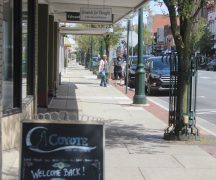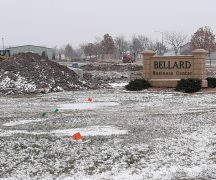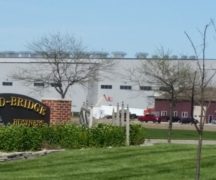By DAVID DUPONT
BG Independent News
Tim Mayle, the executive director of the Center for Advanced Manufacturing and Logistics, doesn’t have a business card yet.
The center doesn’t have a website, never mind a branding strategy.
None of that, however, has stopped Mayle from getting to work helping area manufacturers.
Mayle talked about possibilities for the center at the recent Bowling Green Economic Development office’s annual luncheon.
The launching of the center, which was made possible by $2 million from the state, was announced in November 2021. Mayle, former director of Findlay-Hancock County Economic Development, took over as the center’s executive director in November.
The center will bring together the resources of BGSU, Owens Community College, and the University of Findley to provide a myriad of services to local industry.
In his remarks BGSU President Rodney Rogers, noted that Northwest Ohio is already a hub for advanced manufacturing. Among the state’s economic development regions, it has the highest percentage of its workforce engaged in manufacturing.
And the I-75 corridor from Detroit to Dayton has the highest concentration of robotic technology in the state.
BGSU is developing its academic offerings in advanced manufacturing through the College of Technology, Architecture, and Applied Engineering.
Owens for its part is noted for its training programs. Owens President Dionne Somerville said that the center provides industry with a one-stop contact to address its needs.
“Our mission is to push the region forward.”
She noted that a company was taking advantage of an Owens program through which participants earned an associate degree. The company said they needed a program to grant a bachelor’s degree.
“No problem, we have partners who can do that,” she said.
The University of Findlay has an All Hazards Training Center. It provides the skills, Mayle noted, needed to address situations such as the derailment in Palestine, Ohio, earlier this year.
The center is a national leader in customized health and safety training that’s crucial to all industries,” Darin Fields, UF’s vice president for academic affairs.
The advanced manufacturing center is still getting up and running Mayle said.
Yet it already helped one company save millions of dollars.
Mayle said he was surprised on assuming his new duties how much the institutions were already offering.
Already, the center has been able to connect a company working on ways of degrading plastics with a researcher at BGSU who is studying that technology. Neither was aware of the other’s work, Mayle said.
The current economic situation makes the center’s work even more needed.
“If you’re in manufacturing right now, I’m sure your procurement offices and logistics offices are facing challenges they’ve never seen before,” Mayle said.
One company had a 400-day lag time from when material was purchased to when it arrived in a U.S. port.
Using the resources available at BGSU, the center was able to look at everything the company imported. Some goods it made sense to import, but in other cases the difference in price may be less than a cent.
The study looked at all the costs involved in getting that order from overseas. “In some cases, it was cheaper to make it in North America,” he said.
The center was able to help locate companies that could do the job.
Then they found using a vertical analysis of the company’s operation that the firm could make some parts itself.
BGSU faculty then helped with the putting together the robotics line needed.
“In one instance the savings was over $20 million,” Mayle said.
“Companies are so leaned out and people are wearing so many hats and people are so focused on getting the part out the door, which I understand, that they don’t really have the time or resources to do the technical analysis.”
At the center, he said, “I have a deep bench between three schools to do this work.”
The center will also focus on work force issues. Companies need workers from across the board. It can help connect industry with students.
Engineering technology students, for example, need three co-op placements.
There are more than 1,000 students in the program.
The center can help companies set up those programs to fit what students need.
Studies show that 90 percent of students who have a co-op placement with a company, end up working full-time for the firm.
The center also needs input and support from industry, Mayle said. They may need to buy new equipment such as that used in industry to properly train employees.
Some businesses, he said, worry that they will train people and they will leave.
He said the concern should be what happens if they don’t train them, and they stay.
One company the center has helped produces heavy steel parts. Moving those parts was causing a lot of injury and employee turnover. \“Can you help us communicate to employees how to do this job?”
The solution may be as simple as effective signs, Mayle said. “It’s day-to-day operations.”





